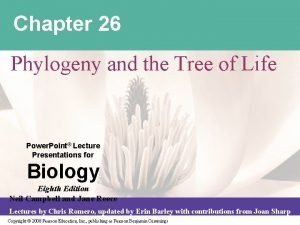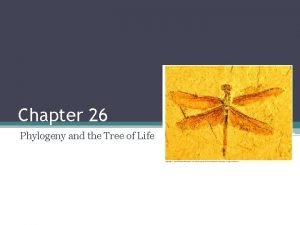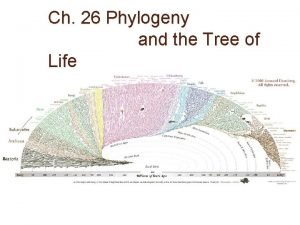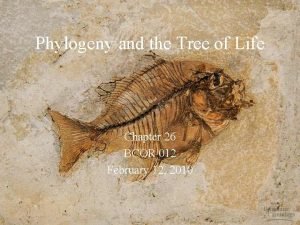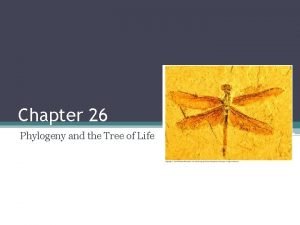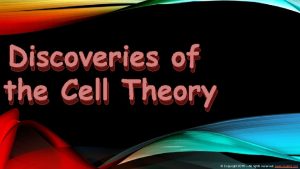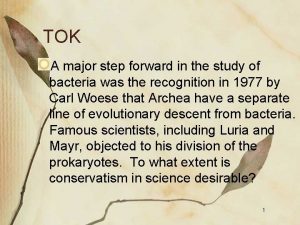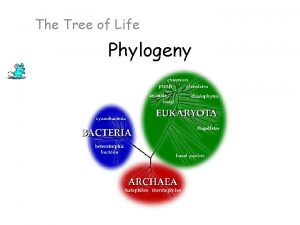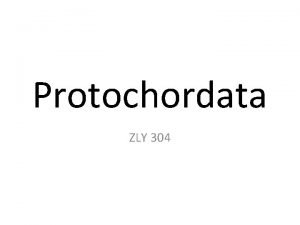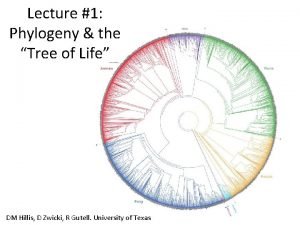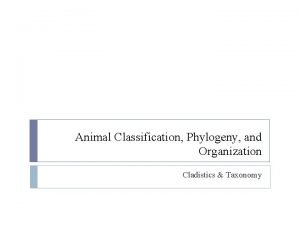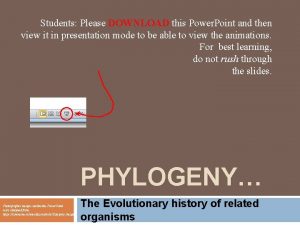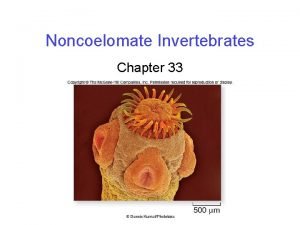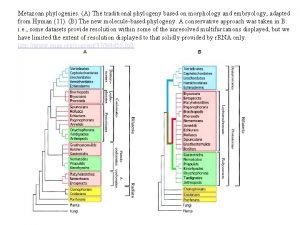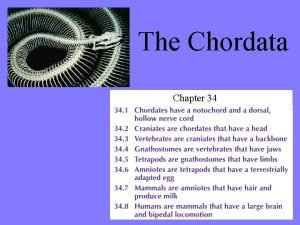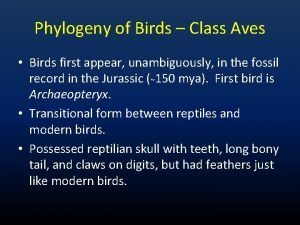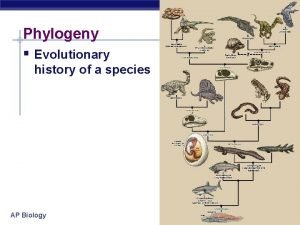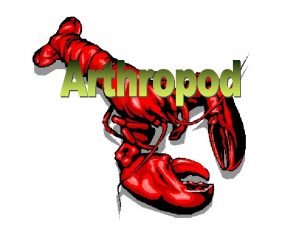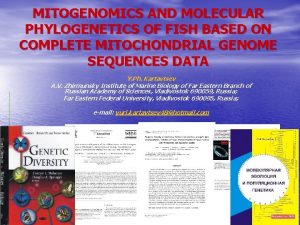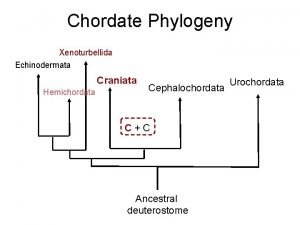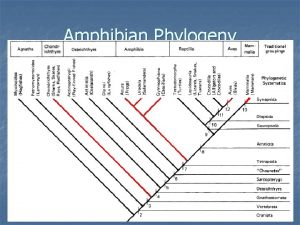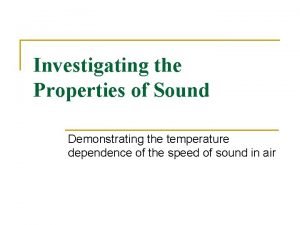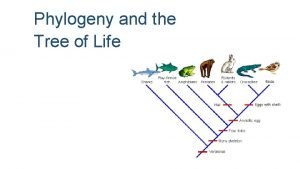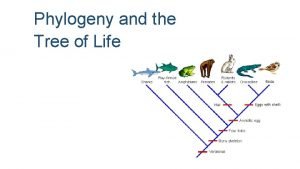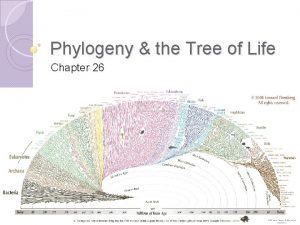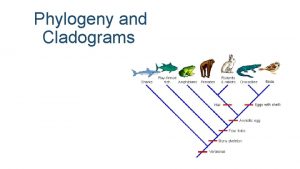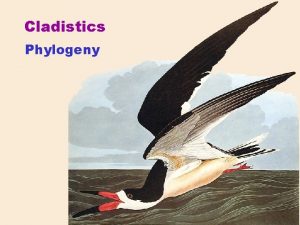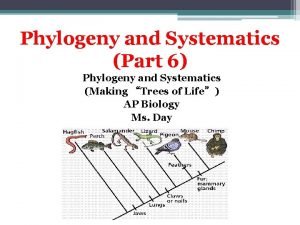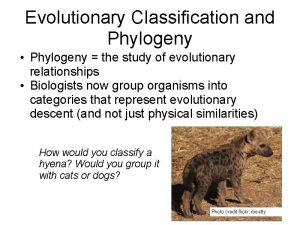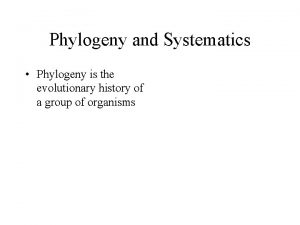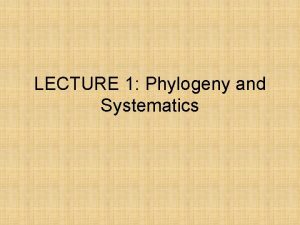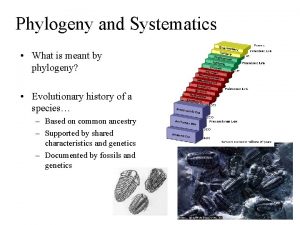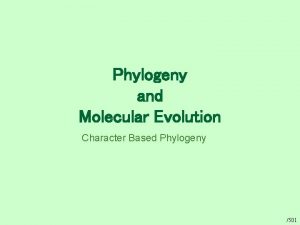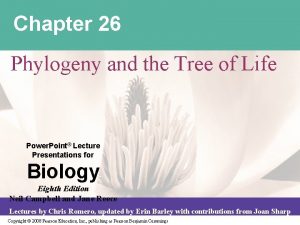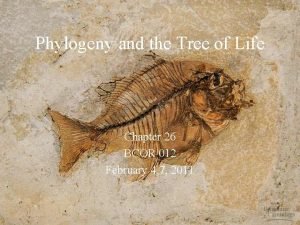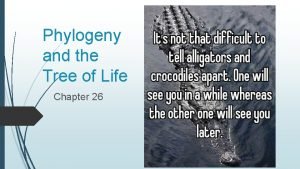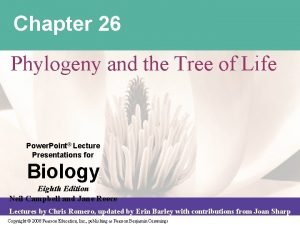Phylogeny and the Tree of Life Overview Investigating





































- Slides: 37

Phylogeny and the Tree of Life

Overview: Investigating the Tree of Life • Phylogeny is the evolutionary history of a species or group of related species • The discipline of systematics classifies organisms and determines their evolutionary relationships • Systematists use fossil, molecular, and genetic data to infer evolutionary relationships

Taxonomy • The science of classifying organisms. • Tells us about the degree of relation between different organisms

Taxonomy • Developed by Swedish biologist Carolus Linnaeus (1707 — 1778). • Binomial naming system

Tiger Classification Domain: Eukarya Kingdom Animalia Phylum Chordata Class Mammalia Order Carnivora Family Felidae Genus Panthera Species tigris Dude, Keep Plates Clean Or Family Gets Sick Dear King Phillip climbed over the fence and got shot

Biological Nomenclature A species is both defined by its genus name and specific name. Ex. Panthera tigris Panthera- genus name tigris- species name

Biological Species Organisms that are genetically similar, and have ability to interbreed and produce viable, fertile offspring

Subspecies Might interbreed if a barrier or other challenge was removed (such as distance). Hawaiian endemic snails (kahuli)

Hybrids Offspring is sterile Panthera tigris Panthera leo tigon

Three-domain system Prokaryotes Extremophiles Eukaryotes Look at how this evolution happened!

Linking Classification and Phylogeny • Systematists depict evolutionary relationships in branching phylogenetic trees • Linnaean classification and phylogeny can differ from each other • Systematists have proposed the Phylo. Code, which recognizes only groups that include a common ancestor and all its descendants

Fig. 26 -4 Order Family Genus Species Taxidea taxus Lutra Mustelidae Panthera Felidae Carnivora Panthera pardus Lutra lutra Canis Canidae Canis latrans Canis lupus

Fig. 26 -5 Branch point (node) Taxon A Taxon B Taxon C ANCESTRAL LINEAGE Taxon D Taxon E Taxon F Common ancestor of taxa A–F Polytomy: more than 2 groups emerge Sister taxa

What We Can and Cannot Learn from Phylogenetic Trees • Phylogenetic trees do show patterns of descent • Phylogenetic trees do not indicate when species evolved or how much genetic change occurred in a lineage • It shouldn’t be assumed that a taxon evolved from the taxon next to it • Applications: whale meat sold illegally in Japan

Phylogenies are inferred from morphological and molecular data • To infer phylogenies, systematists gather information about morphologies, genes, and biochemistry of living organisms • Organisms with similar morphologies or DNA sequences are likely to be more closely related than organisms with different structures or sequences

Compare the bones Homologous Structures are similarities due to shared ancestry, such as the bones of a whale’s flipper and a tiger’s front limb.

Convergent Evolution • Convergent Evolution: has taken place when two organisms developed similarities as they adapted to similar environmental challengesnot because they evolved from a common ancestor. • Example: The streamlined bodies of a tuna and a dolphin show convergent evolution.

But don’t be fooled by these… Analogous structures • • • look similar on the outside Same function different structure & development on the inside different origin no evolutionary relationship Solving a similar problem with a similar solution

Analogous structures Dolphins: aquatic mammal Fish: aquatic vertebrate • • both adapted to life in the sea not closely related

Evaluating Molecular Homologies • Systematists use computer programs and mathematical tools when analyzing comparable DNA segments from different organisms

Fig. 26 -8 1 Deletion 2 Types of mutations that notmally occur Insertion 3 Orange sections no longer align 4 only with addition of gaps will they align

• It is also important to distinguish homology from analogy in molecular similarities • Mathematical tools help to identify molecular homoplasies, or coincidences • Molecular systematics uses DNA and other molecular data to determine evolutionary relationships

Shared characters are used to construct phylogenetic trees • Cladistics groups organisms by common descent • A clade is a group of species that includes an ancestral species and all its descendants • A valid clade is monophyletic, signifying that it consists of the ancestor species and all its descendants • A paraphyletic grouping consists of an ancestral species and some, but not all, of the descendants • A polyphyletic grouping consists of various species that lack a common ancestor

Fig. 26 -10 Includes all descendants A A A B B C C C D D D E E F F F G G G B Group I (a) Monophyletic group (clade) Group II (b) Paraphyletic group E Group III (c) Polyphyletic group

Shared Ancestral and Shared Derived Characters • In comparison with its ancestor, an organism has both shared and different characteristics • A shared ancestral character is a character that originated in an ancestor of the taxon (vertebrae in mammals) • A shared derived character is an evolutionary novelty unique to a particular clade (hair in mammals) • A character can be both ancestral and derived, depending on the context, it is useful to know in which clade a shared derived character first appeared

Fig. 26 -11 Lamprey Tuna Salamander Turtle Leopard Lancelet (outgroup) CHARACTERS TAXA Vertebral column (backbone) 0 1 1 1 Hinged jaws 0 0 1 1 Lamprey Tuna Vertebral column Salamander Hinged jaws Four walking legs 0 0 0 1 1 1 Amniotic (shelled) egg 0 0 1 1 Hair 0 0 0 1 (a) Character table Turtle Four walking legs Amniotic egg Leopard Hair (b) Phylogenetic tree


An organism’s evolutionary history is documented in its genome • Comparing nucleic acids or other molecules to infer relatedness is a valuable tool for tracing organisms’ evolutionary history • DNA that codes for r. RNA changes relatively slowly and is useful for investigating branching points hundreds of millions of years ago • mt. DNA evolves rapidly and can be used to explore recent evolutionary events

Gene Duplications and Gene Families • Gene duplication increases the number of genes in the genome, providing more opportunities for evolutionary changes • Like homologous genes, duplicated genes can be traced to a common ancestor • Orthologous genes are found in a single copy in the genome and are homologous between species • They can diverge only after speciation occurs

• Paralogous genes result from gene duplication, so are found in more than one copy in the genome • They can diverge within the clade that carries them and often evolve new functions

Molecular Clocks • They are methods used to measure the absolute time of evolutionary change based on the observation that some genes and other regions of the genome appear to evolve at constant rates. • The underlying assumption for molecular clocks is that the number of nucleotide substitutions in related genes is proportional to the time that has elapsed since the genes branched from their common ancestor.

New information continues to revise our understanding of the tree of life • Recently, we have gained insight into the very deepest branches of the tree of life through molecular systematics

Biological Kingdoms Five kingdom system Monera : Protista Plantae Fungi Animalia Six kingdom system: Eubacteria Archaebacteria Protista Three domain system: Eubacteria Archaebacteria E U K A R Y A Protista Archaebacteria Chromista Eubacteria Archezoa Eight kingdom system: Plantae Fungi Animalia

Fig. 26 -21 EUKARYA Dinoflagellates Forams Ciliates Diatoms Red algae Land plants Green algae Cellular slime molds Amoebas Euglena Trypanosomes Leishmania Animals Fungi Sulfolobus Green nonsulfur bacteria Thermophiles Halophiles (Mitochondrion) COMMON ANCESTOR OF ALL LIFE Methanobacterium ARCHAEA Spirochetes Chlamydia Green sulfur bacteria BACTERIA Cyanobacteria (Plastids, including chloroplasts)

A Simple Tree of All Life • The tree of life suggests that eukaryotes and archaea are more closely related to each other than to bacteria • The tree of life is based largely on r. RNA genes, as these have evolved slowly

Is the Tree of Life Really a Ring? • Some researchers suggest that eukaryotes arose as an endosymbiosis between a bacterium and archaean • If so, early evolutionary relationships might be better depicted by a ring of life instead of a tree of life

Fig. 26 -23 Eukarya Bacteria Archaea
 Phylogenetic bracketing
Phylogenetic bracketing Chapter 20 phylogeny and the tree of life
Chapter 20 phylogeny and the tree of life Monophyletic group
Monophyletic group Chapter 26 phylogeny and the tree of life
Chapter 26 phylogeny and the tree of life Chapter 26 phylogeny and the tree of life
Chapter 26 phylogeny and the tree of life Chapter 26 phylogeny and the tree of life
Chapter 26 phylogeny and the tree of life Sister groups on a phylogenetic tree
Sister groups on a phylogenetic tree Investigating and making a case for drug diversion
Investigating and making a case for drug diversion Cell theory contributors
Cell theory contributors Outgroup in phylogeny
Outgroup in phylogeny Ingroup phylogenetic tree
Ingroup phylogenetic tree Phylogeny of protochordata
Phylogeny of protochordata Barnacle phylogeny
Barnacle phylogeny Taxa biology
Taxa biology Sister taxa
Sister taxa Animal kingdom cladogram
Animal kingdom cladogram Phylogeny
Phylogeny Fur
Fur Monophyletic group
Monophyletic group Invertebrate phylogeny
Invertebrate phylogeny Metazoan phylogeny
Metazoan phylogeny Anatomy of trout
Anatomy of trout Avian phylogeny
Avian phylogeny Cat family tree
Cat family tree Clustal omega
Clustal omega Phylogenetic tree
Phylogenetic tree Define descent with modification
Define descent with modification Arthropoda phylogeny
Arthropoda phylogeny Fish phylogeny
Fish phylogeny Chordate
Chordate Phylogeny is the study of _____.
Phylogeny is the study of _____. Lungfish vs spotted salamander
Lungfish vs spotted salamander Investigating the properties of sound
Investigating the properties of sound Investigating science hsc
Investigating science hsc Practice a investigating graphs of polynomial functions
Practice a investigating graphs of polynomial functions Investigating graphs of functions for their properties
Investigating graphs of functions for their properties Unit 14 customer service
Unit 14 customer service Investigating the world of work. lesson 1
Investigating the world of work. lesson 1
